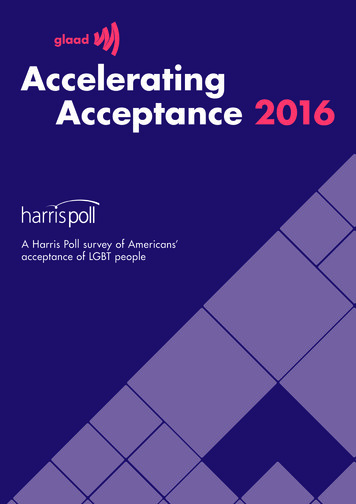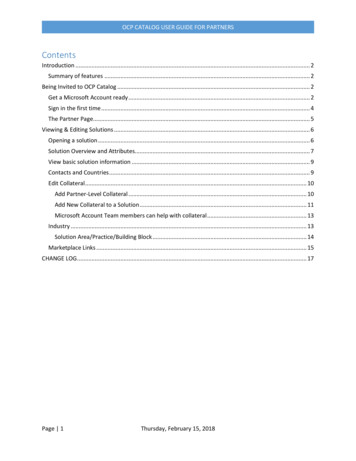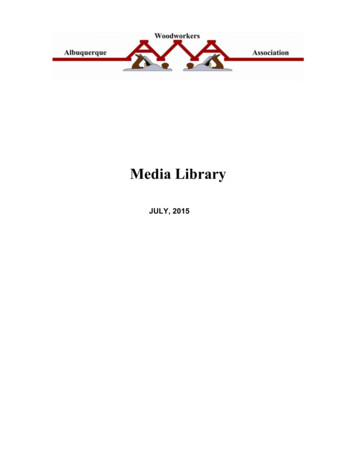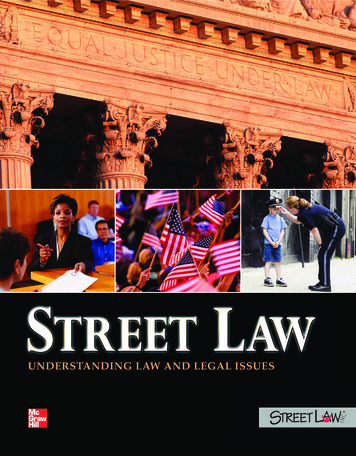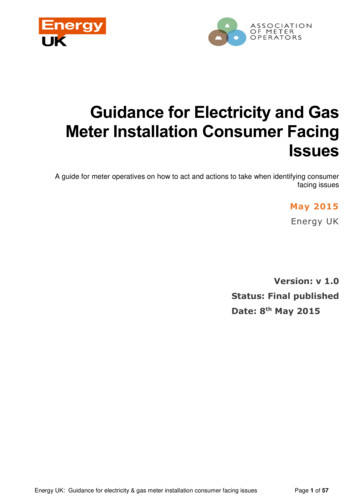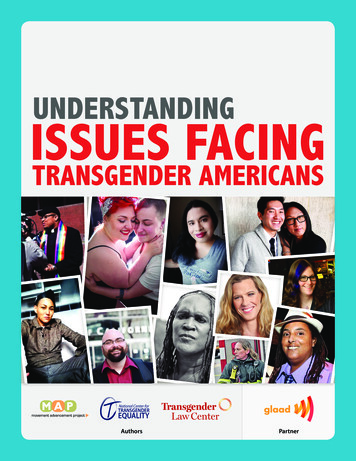
Transcription
UNDERSTANDINGISSUESFACINGTRANSGENDER AMERICANSNational Center forTRANSGENDEREQUALITYAuthorsPartner
This report was authored by:Contact InformationMovement Advancement ProjectThe Movement Advancement Project (MAP) is anindependent think tank that provides rigorousresearch, insight and analysis that help speed equalityfor LGBT people. MAP works collaboratively withLGBT organizations, advocates and funders, providinginformation, analysis and resources that help coordinateand strengthen their efforts for maximum impact. MAPalso conducts policy research to inform the public andpolicymakers about the legal and policy needs of LGBTpeople and their families.Movement Advancement Project (MAP)2215 Market StreetDenver, CO 80205contact@lgbtmap.orgwww.lgbtmap.orgNational Center for Transgender EqualityThe National Center for Transgender Equality (NCTE) isthe nation’s leading social justice advocacy organizationwinning life saving change for transgender people.NCTE was founded in 2003 by transgender activistswho recognized the urgent need for policy change toadvance transgender equality.National Center for Transgender Equality1325 Massachusetts Ave. NW, Suite 700Washington, DC 20005202-903-0112www.transequality.org2Transgender Law CenterFounded in 2002, Transgender Law Center (TLC) is nowthe largest transgender-led organization in the UnitedStates dedicated to advancing transgender rights. TLCchanges law, policy and attitudes so that all people canlive safely, authentically, and free from discriminationregardless of their gender identity or expression.GLAAD5455 Wilshire Blvd, #1500Los Angeles, CA 90036323-933-2240www.glaad.orgTransgender Law Center:1629 Telegraph Avenue, Suite 400Oakland, CA 94612415-865-0176www.transgenderlawcenter.orgAbout this report:This report is part of a series of publications that includes:This report was developed in partnership with:GLAADGLAAD rewrites the script for LGBT acceptance. As adynamic media force, GLAAD tackles tough issues toshape the narrative and provoke dialogue that leadsto cultural change. GLAAD protects all that has beenaccomplished and creates a world where everyone canlive the life they love. Understanding Issues Facing LGBT Americans Understanding Issues Facing Bisexual Americans Understanding Issues Facing Transgender AmericansThe series is a primer that introduces the major areasin which LGBT Americans face legal barriers to fullyparticipating in life and provides a summary of whatadvocates are doing to work for change. This reportincorporates information current as of February 2015.Please see www.lgbtmap.org/progress-toward-equalityfor more information.Photo Credits:Top row second from left credit: Kinzie FergusonTop row right corner credit: Audrey LeczinskyBottom row third from left credit: Waning MoonPhotographyBottom row right corner credit: AKMeyer
TABLE OF CONTENTSINTRODUCTION.1TRANSGENDER AMERICANS IN PROFILE.1BARRIERS TO EQUALITY FOR TRANSGENDER AMERICANS.2Discrimination in Public Accommodations. 2Discrimination in Employment. 2Discrimination in Housing. 4Discrimination in Education . 4Health . 6Violence . 7Inaccurate Identity Documents. 8Marriage and Family. 9Interactions with the Criminal Justice System. 10Immigration. 11CONCLUSION.12ENDNOTES.14ACKNOWLEDGEMENTS.163
4
INTRODUCTIONTransgender Americans are experiencing a uniquemoment in history. Rising visibility, unprecedentedadvocacy, and changing public opinion are working toprovide transgender people greater legal protectionsthan ever before. At the same time, many transgenderpeople, particularly transgender women andtransgender people of color, still face enormous barriersto their safety, health, and well-being.This guide provides a high-level introduction foradvocates and allies to the issues facing transgenderAmericans, as well as recommendations for change.A note about terminology:As used in this document, the word “transgender”describes individuals whose sex at birth is different fromwho they know they are on the inside. At some point intheir lives, many transgender people decide they mustlive their lives as the gender they have always knownthemselves to be, and transition to living as that gender.“Gender identity” is a person’s deeply-felt innersense of being male, female, or something otheror in-between. “Gender expression” is a person’scharacteristics and behaviors such as appearance, dress,mannerisms and speech patterns that can be describedas masculine or feminine. Note that gender identityand expression are independent of sexual orientation,and transgender people may identify as heterosexual,gay, lesbian, bisexual, or queer. Transgender peopleexperience discrimination because of their genderidentity and gender expression, and may also experiencediscrimination because of their sexual orientation orperceived sexual orientation.1Transgender Americans live and work in communitiesin every state.1 Transgender Americans have families, workhard to earn a living, pay taxes, and serve their communitiesand their country. Surveys estimate that between 0.3% and0.5% of Americans identify as transgender.2 Applying thesefigures to the total number of adults in the United States,this research suggests that there are nearly one milliontransgender adults across the nation.Transgender people are racially and ethnicallydiverse.3 Many transgender people are parents:4 the NTDSfound that 38% of respondents reported being a parent.5American Indian and Latino/a transgender people reportparenting or financially supporting a child at higher ratesthan white transgender people (see Figure 1).6Transgender people are becoming more visible inAmerican society and popular culture. Actress LaverneCox appeared on the cover of Time in May 2014, andthe following November was declared one of Glamour’sWomen of the Year. Author Janet Mock released hermemoir of growing up transgender, Redefining Realness,in February 2014. And Amazon Studios recentlydebuted “Transparent,” a critically acclaimed comedydrama about the ramifications when a transgenderwoman comes out to her family.Figure 1: Transgender Parentingby Race (% of respondents by race currentlysupporting a dependent eBlackMultiracialAsian/PacificIslanderSource: Rebecca L. Stotzer, Jody L. Herman, and Amira Hasenbush, “Transgender Parenting: AReview of Existing Research,” Williams Institute, October 2014, ing/transgender-parenting-oct-2014.TRANSGENDER AMERICANS IN PROFILEOne challenge in assessing the impact of thesebarriers is a pronounced lack of data on the lives oftransgender Americans. Very few surveys ask abouttransgender status, and there is only one national studyfocused exclusively on transgender people in the UnitedStates: the National Transgender Discrimination Survey(NTDS). As more state and federal agencies includequestions about gender identity and expression in theirsurveys and data collections, it will be possible to painta more detailed and accurate picture of the lives oftransgender people and the disparities they face.TRANSGENDER AMERICANS INPROFILE
2BARRIERS TO EQUALITY FORTRANSGENDER AMERICANSThis section of the guide discusses the barriers toequality facing transgender people because of theirgender identity and/or expression, as well as the impactof these barriers on transgender people’s health, safety,and economic security. The challenges described beloware exacerbated for transgender women and transgenderpeople of color, who often experience deeper inequalityin specific areas compared to transgender men andwhite transgender people.BARRIERS TO EQUALITY FOR TRANSGENDER AMERICANSDiscrimination in PublicAccommodationsPublic accommodations are places accessible to thepublic, such as retail stores, restaurants, parks, hotels,libraries, movie theatres, and banks. In a 2014 studyconducted in Massachusetts, 65% of transgender peoplereported experiencing discrimination in a place of publicaccommodation in the past 12 months.7 The studyrevealed that bathrooms in restaurants, libraries, cinemas,shopping malls, airports, and other public places werealso locations of frequent, sometimes serious harassmentand abuse of transgender people. Transgender peoplewho reported discrimination in public accommodationsoften had increased physical and emotional healthproblems as a result. The study found that discriminationcaused transgender people to postpone health care, whilesimultaneously increasing negative health outcomes.Only 17 states and D.C. prohibit discrimination in publicaccommodations on the basis of gender identity, coveringjust 36% of Americans.8Local, state, and federal governments shouldexplicitly prohibit public accommodation discriminationon the basis of gender identity and sexual orientation,while ensuring that transgender people can be safe inthese places. Where possible, single-user restroomsshould be designated as gender-neutral, and transgenderpeople should be assured safe access to facilities thatmatch their gender identity.Discrimination in rimination at work. Between 13% and 47% oftransgender workers report being unfairly denied ajob,9 and 78% report being harassed, mistreated, ordiscriminated against at work, as shown in Figure 2.10Figure 2: Transgender Workplace DiscriminationTransgender peoplewho were unfairlyfired or deniedemploymentTransgender andgender-nonconformingemployees whoexperience harassment,mistreatment, ordiscrimination on the job13-47%78%Sources: M.V. Lee, Badgett, Holning Lau, Brad Sears, and Deborah Ho, “Bias in the Workplace:Consistent Evidence of Sexual Orientation and Gender Identity Discrimination,” The WilliamsInstitute, June 2007. Deena Fidas and Liz Cooper, “The Cost of the Closet and the Rewards ofInclusion,” Human Rights Campaign Foundation, May 2014.Transgender workers of color report higher rates of jobloss and employment discrimination compared to whitetransgender workers.11 Common forms of employmentdiscrimination against transgender people include:unfairly firing or refusing to hire someone because theyare transgender; prohibiting a transgender employeefrom dressing or appearing in accordance with theirgender identity; limiting a transgender employee’sinteractions with customers; denying access to restroomsconsistent with the employee’s gender identity; using thewrong name or pronouns; outing a transgender employeeto others or asking inappropriate questions; requiring atransgender employee to have updated identificationdocuments or certain medical procedures in order towork or be hired as their self-identified gender. Employersalso frequently only offer discriminatory health plans thatexclude coverage for transition-related care.Currently, only 18 states have clear laws prohibitingemployment discrimination on the basis of genderidentity or expression (see Figure 3 on the nextpage).12 There is no federal law that explicitly prohibitsdiscrimination against transgender employees, but thereare some protections in place. Both the U.S. AttorneyGeneral and the U.S. Equal Employment OpportunityCommission (EEOC) have interpreted Title VII of theCivil Rights Act of 1964, which prohibits discrimination“because of sex,” to protect transgender workers.However, while the EEOC often mediates discriminationclaims between employers and employees, and EEOCattorneys can prosecute employers in court, courts arenot strictly bound to follow its interpretation of the law. Inother words, a private employer who does not agree withan EEOC decision can refuse to abide by it, in which casethe employee or EEOC must pursue the case in federal
Figure 3: State-Level Employment Nondiscrimination LawsState-Level Employment Nondiscrimination LAFLHIEmployment nondiscrimination law covers only sexual orientation (3 states)Local, state, and federal governments shouldlegislate or implement employment protections thatprohibit discrimination on the basis of gender identityand expression. Congress should pass explicit federalemployment protections. Federal agencies such as theDOJ, EEOC, and the Department of Labor should educateemployers and employees about existing protections andadopt guidelines for private employers to comply withfederal protections. In addition, job training programsshould be inclusive and specifically address the needs oftransgender and gender non-conforming people.No employment nondiscrimination law covering sexual orientation orgender identity (29 states)Source: Movement Advancement Project, “LGBT Equality Maps: Non-Discrimination Laws.”Military ServiceDespite the repeal of the U.S. military’s “Don’tAsk Don’t Tell” policy in 2010, which prohibitedopen service by lesbian, gay, or bisexual servicemembers, transgender service members are stillnot permitted to serve openly. In 2014, severalpublic figures, including former Secretary ofDefense Chuck Hagel, then-House Speaker NancyPelosi, and Air Force Secretary Deborah LeeJames, spoke about the need to update militaryregulations to allow open service by transgenderpeople. In August, a high-level commissionconvened by the military research think tankThe Palm Center recommended immediate openservice for transgender service members.13Concurrently, transgender veterans are returninghome from service to find a lack of support.Transgender veterans have a higher rate of suicidecompared to the general population.14 In a recentlandmark case, the U.S. Army agreed to changethe names on key identity documents of twotransgender veterans, clearing the way for otherveterans to obtain updated records and easieraccess to veterans’ benefits.15Lower Income for Transgender PeopleOutdated and archaic laws and still-pervasive biasand discrimination mean that LGBT people across theUnited States pay an unfair price for being who theyare.17 Transgender people, especially transgenderpeople of color, pay a particularly steep price.Discrimination and higher costs collude to reduceearning power and savings and keep transgenderpeople in poverty. The NTDS study of transgenderAmericans found they are far more likely to be poorwhen compared to the larger U.S. population. In fact,transgender Americans were nearly four times morelikely to have a household income under 10,000 peryear than the population as a whole (15% vs. 4%).18This is true despite 87% of transgender adults havingcompleted at least some college and 47% havingobtained a college or graduate degree–rates muchhigher than the general population.In addition, transgender people of color report muchhigher rates of extreme poverty.19 Asian and PacificIslander (API) transgender people were six times aslikely to report extremely low incomes compared toother API Americans, while 34% of black transgenderrespondents and 28% of Latino transgenderrespondents reported incomes at this level.20See Paying an Unfair Price: The Financial Penalty forBeing Transgender in America for more informationon economic security for transgender people.3BARRIERS TO EQUALITY FOR TRANSGENDER AMERICANSEmployment nondiscrimination law covers sexual orientation and genderidentity (18 states D.C.)court. The EEOC’s rulings are binding on the federalgovernment, and in 2014, President Obama issued anexecutive order expressly prohibiting discriminationagainst LGBT employees of the federal government andLGBT employees working for federal contractors.16
BARRIERS TO EQUALITY FOR TRANSGENDER AMERICANS4Discrimination in HousingAdequate and affordable housing is essential tothe economic security and overall well-being of everyAmerican. However, one in five transgender people(19%) in the United States have been refused a home orapartment and more than one in ten (11%) have beenevicted because of their gender identity.21 Homelessnessis a critical issue for transgender people, with one in fivehaving experienced homelessness at some time in theirlives because of discrimination and family rejection (seeFigure 4).22 Unfortunately, transgender people facinghomelessness also face discrimination from agenciesthat should be helping them, with nearly one in three(29%) reporting being turned away from a shelter due totheir transgender status.23The Department of Housing and Urban Development(HUD) issued guidance and regulations in recent yearsthat provide transgender people with limited protectionsfrom housing discrimination.24 However, no federalstatute explicitly prohibits evicting someone, refusingto rent to someone, or refusing to loan to someonebecause of gender identity/expression. Similarly, only18 states and D.C. have clear laws prohibiting housingdiscrimination on the basis of gender identity, covering39% of Americans.25Local, state, and federal governments shouldexplicitly prohibit housing and lending discriminationon the basis of gender identity and sexual orientation.Shelters should provide access to transgender peopleon a nondiscriminatory basis, including housing peoplein sex-segregated facilities based on gender identity.Congress should fully fund and implement the legislationsuch as Federal Plan to End Homelessness, which wouldexpand access to affordable housing. Local, state, andfederal agencies should implement homelessness datacollection that includes data on gender identity andsexual orientation.Discrimination in EducationSchools are difficult places for transgender studentsas they regularly face discrimination, bullying, andharassment in elementary, secondary, and post-secondaryinstitutions. In one survey, 40% of gender non-confirmingyoutha reported being frequently harassed by their peersand 37% reported frequent verbal harassment and namecalling.26 In another survey, 33% of all students reportedfrequently hearing anti-transgender slurs.27 The samestudy found that levels of physical and verbal harassmentwere very high among surveyed students (see Figure 5).This harassment, bullying, and discrimination have acumulative negative effect on education and achievementfor transgender people: students who are bullied and facediscrimination because of their gender expression aremore likely to miss school, have lower GPAs, not plan toattend post-secondary education, and have higher levelsof depression and lower self-esteem.28Across the United States, only 13 states have lawsthat clearly protect students against discriminationbecause of their gender identity and/or expression, andFigure 5: Experiences of Transgender Students in SchoolBased on Their Gender Expression(% of transgender students)Figure 4: Homelessness by Race75.2%73.6%(% of respondents who report ever becoming homeless)63.4%52.1%41%33%32.5%32%29%16.2%19%Felt Unsafeat tino/aWhiteMultiracialSource: Jamie M. Grant, Lisa A. Mottet, and Justin Tanis, “Injustice at Every Turn: A Report ofthe National Transgender Discrimination Survey,” National Center for Transgender Equality andNational LGBTQ Task Force, 2011, dedBathroomsAvoidedLockerRoomsSource: J.G. Kosciw, E.A. Greytak, N.A. Palmer, & M.J. Boesen, “The 2013 National School ClimateSurvey: The experiences of lesbian, gay, bisexual and transgender youth in our nation’s schools,”GLSEN, 2014, www.glsen.org/nscs.aThe report defines gender-expansive youth in the survey as those who selected “transgender” or“other” when asked if they considered themselves “male, female, transgender or other gender.”
only 18 states expressly prohibit bullying on the basisof gender identity and/or expression (see Figure 6).29 In2013, California passed a law ensuring that transgenderstudents have the opportunity to participate fully in allschool programs, activities, sports teams, and facilities.30Over a dozen states have passed similar policies toensure that transgender students can participate in highschool sports. In 2014, four women’s colleges amendedtheir admission policies to make clear that they accepttransgender students: Mt. Holyoke College, Mills College,Simmons College, and Scripps College.Figure 6: Safe School LawsSchool Nondiscrimination ress should pass laws expressly prohibitingdiscrimination in education on the basis of genderidentity and sexual orientation, as well as lawsrequiring all schools to implement comprehensive andeffective anti-bullying and anti-harassment policiesthat specifically include gender identity and sexualorientation. The National Center for Education Statisticsshould ensure that data collection includes detailedinformation about bullying, harassment, and otherschool violence, including whether the victim’s genderidentity or expression were at issue.Persistent Bullying and HarassmentGAALLAFLHILaw prohibits discrimination in schools based on sexual orientation andgender identity (13 states D.C.)Law prohibits discrimination in schools based on sexual orientation only(1 state)* Law prohibits discrimination in schools based on association with someonewith a listed characteristic (2 states)No law protecting LGBT students (36 states)Anti-Bullying WYALGALAFLHILaw prohibits bullying based on sexual orientation and gender identity(18 states D.C.)* Law prohibits bullying based on association with someone with a listedcharacteristic (5 states D.C.)No law protecting LGBT students (32 states)Source: Movement Advancement Project, “LGBT Equality Maps: Safe Schools Laws.”Jewlyes Gutierrez was charged with misdemeanorbattery after an altercation between her and severalother students was caught on video in November,2013. The subject of persistent harassment andintimidation at school, Ms. Gutierrez had previouslysought intervention and support from Hercules Highstaff with no success. Local organizations such as theTransgender Law Center, RYSE Youth Center (RYSE,)and Rainbow Community Center rallied in support ofMs. Gutierrez. As a result, she was able to enter into anagreement with the court to have her case reevaluatedupon the completion of a restorative justice programconducted by the National Council on Crime andDelinquency (NCCD). After reviewing the case in May2014, Judge Thomas M. Maddock dropped the chargein recognition of Ms. Gutierrez’s successful completionof the restorative justice program. Restorative justicepractices aim precisely for the results produced in thiscase—facilitating individual and community healingand accountability and working to protect youngpeople of color, who have the highest inequitablerates of contact, from entry and engagement in thejuvenile justice system.Source: Transgender Law Center, “Charge Dropped Against Transgender Student,Restorative Justice at Work,” RRIERS TO EQUALITY FOR TRANSGENDER AMERICANSWANationally, the U.S. Department of Education in 2014issued guidance confirming that the federal Title IX sexdiscrimination law protects transgender students, andpublicized two Title IX settlements on behalf of transgenderstudents. Title IX applies to all K-12 schools, colleges, anduniversities that accept federal funds. Unfortunately,at least three colleges have successfully applied forexemptions from this law, citing religious objections.
BARRIERS TO EQUALITY FOR TRANSGENDER AMERICANS6HealthTransgender people report low insurance rates andshockingly high rates of negative health outcomes.31 TheAffordable Care Act (ACA) has decreased the numberof transgender people without insurance and has alsoprohibited plans sold in state and federal health insurancemarketplaces from discriminating against enrollees onthe basis of gender identity.32 Nine states and DC haveadopted rules requiring insurance plans to eliminatetransgender-specific exclusions (see Figure 7),33 and in2014, the Department of Health and Human Servicesended Medicare’s ban on coverage for transgenderspecific care. But deep disparities remain, including lowerrates of coverage and continued exclusions of medicallynecessary transition-related care in plans run by privateemployers and many public plans, including many stateMedicaid plans and the Veterans Health Administration.Only 40% of respondents to the National TransgenderDiscrimination Survey reported accessing healthinsurance through their current or former employer,34compared to 44.6% of Americans.35 Ten percent ofrespondents accessed coverage through Medicareor Medicaid and 10% purchased their own privatecoverage.36 African-American respondents had theworst health insurance coverage of any racial category:39% reported private coverage and 30% public.37Sixty percent of respondents reported accessinghealth care through their doctor’s office, with 28%seeking care at health centers and clinics, and 4%primarily accessing care in emergency rooms.38 Lowerincome transgender people and transgender peopleof color were more likely to access care throughemergency rooms: 17% of African-Americans usedemergency rooms for primary care, as did 8% of Latino/arespondents, and 8% of respondents earning under 10,000 per year.39 Unfortunately, 13% of respondentsreported being denied equal care in emergency roomsbecause of their gender identity.40Transgender people often need medical treatmentlike hormones or surgery to bring a person’s body in linewith their gender identity. Despite widespread recognitionof the necessity of such treatments by every majormedical organization in the United States, including theAmerican Medical Association, discriminatory healthcareexclusions still deny transgender people coverage formedically necessary care, including hormone therapy,counseling, and other medical care.Figure 7: State-Level Insurance Nondiscrimination LawsState-Level Insurance Nondiscrimination LAFLHITransgender exclusions in health insurance service coverage prohibited (9states D.C.)Law prohibits health insurance discrimination based on sexual orientation andgender identity (8 states D.C.)Law prohibits health insurance discrimination based on sexualorientation (0 states)No law or policy prohibiting discrimination in insurance protections (39 states)Note: This map does not reflect states which may have removed transgender exclusions from stateMedicaid programs.Source: Movement Advancement Project, “LGBT Equality Maps: Non-Discrimination Laws.”Additionally, transgender people are denied manyroutine preventive services such as Pap smears andprostate exams that are available broadly to nontransgender people. These services may not correspondwith a transgender person’s gender identity or thegender marker on ID documents or health records,and so coverage may be denied through the insurancecarrier, or overlooked or denied by the patient’s healthcare provider.Even when transgender people have full healthinsurance coverage, they often face discrimination byhealth care providers or need to educate their providerson what it means to be transgender. In a survey oftransgender Coloradans, respondents reported almosttwice the number of days with poor physical or mentalhealth compared to the general population.41 A studyin Massachusetts found that 19% of transgenderrespondents had postponed or avoided necessary caredue to mistreatment or discrimination from health careworkers.42 The U.S. Department of Health and HumanServices interprets the Affordable Care Act—whichprohibits sex discrimination by health care organizationsthat accept federal funds—to prohibit bias againsttransgender people. However, federal and most statelaws still do not expressly prohibit such discrimination.
Leo Kattari’s Story: A
Institute, June 2007. Deena Fidas and Liz Cooper, "The Cost of the Closet and the Rewards of Inclusion," Human Rights Campaign Foundation, May 2014. Transgender people who were unfairly fired or denied employment Transgender and gender-nonconforming employees who experience harassment, mistreatment, or discrimination on the job 13-47%
